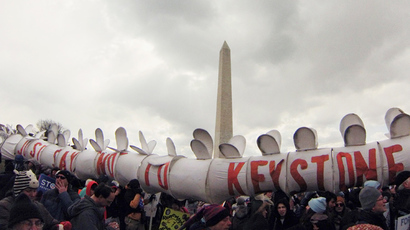Toxic carcinogens from tar sands oil production underestimated - report

Production of crude oil in western Canada emits more harmful carcinogens into the environment than official estimates let on, according to a new study. The Keystone XL pipeline would, if approved, move tar sands oil from Alberta through the US to Texas.
A new study by the University of Toronto-Scarborough published Monday in the Proceedings of the National Academy of Sciences reported that Canadian officials may have underestimated emissions of harmful carcinogens known as polycyclic aromatic hydrocarbons (PAHs) from Alberta tar sands.
Specifically, the report cited the emission levels of PAHs as being one hundred to one thousand times greater than previously believed. High levels of PAHs are not imminently dangerous, though they are quite higher than reported by the mining industry’s environmental impact assessments and Canada’s own National Pollutant Release Inventory. The Canadian government has used these favorable assessments to boost new tar sands development in Alberta’s Athabasca oil sand region.
PAHs are not associated with greenhouse gases, thus do not directly impact climate change. Much of the discussion surrounding the controversial Keystone XL oil pipeline - currently pending approval in the US - has centered around its effects on increased greenhouse gas emissions connected with crude tar sands development. This requires a more energy-intensive process than the production of plain crude oil since a substance known as bitumen must be extracted from the Alberta tar sands, for instance, through means such as surface mining or injecting steam into the ground.
Either way, the operation already uses an excessive amount of water, releases toxic metals into the local environment, and unleashes an estimated 14 to 17 percent more greenhouse gas emissions than regular crude.
Yet PAHs include phenanthrene, pyrene and benzo(a)pyrene, which “are among the most toxic hydrocarbons,” said Jules M. Blais, a University of Ottawa chemical and toxicology professor, according to Climate Central. “They’re some of the worst things out there.”
PAHs should be of concern to anyone living along the Keystone XL route, and those in the nearby vicinity of the Alberta tar sands region are especially at risk.
“From the standpoint of Keystone, the concerns are regarding potential breaches that could contaminate soils,” Blais said. “The same kinds of things that are getting into the Athabasca River could be relevant to Keystone.”
The University of Toronto study - conducted by environmental scientists Frank Wania and Abha Parajulee - used computer models to analyze the plausibility of how many PAHs Canadian officials have estimated are in the Athabasca tar sands region as opposed to the actual measurements of PAH concentrations found there.
"We found that these estimates are insufficient to explain what's being measured in the environment," Wania said, according to Smithsonian.com. “The concentrations of PAHs that should be out there, based on these assumptions, are far too low."
When trying to discern why previous estimates had been so low, the research team found that tar sands tailings ponds - storage ponds used for dumping toxic mining waste - may very well be the culprit.
“In our second set of model calculations, we included tailings ponds and allowed evaporation of PAHs to occur,” Wania said. “The concentration we calculated was closer to what is being measured, so it indicates that quite possibly tailings pond emissions are part of the explanation of why the emissions are too low.”
And since these kinds of emission sources may not have been included in official assessments, the PAHs’ risk to environmental and human health may have been underestimated, Wania said.
“The implication of these results is that the emissions from tailing ponds are being underreported,” said Blais, who is not associated with the study. “We can explain this a number of ways. These emissions from tailing ponds can be very difficult to estimate. They could be occurring below the surface of the ground. They could be below surface, below grade. They could be following fissures or fractures in the rock.”
The US State Department released on Friday a report on the environmental impact of Keystone XL, raising few objections to the prospective ecological damage and harm to human health caused by the pipeline and its functions.
The report said that the $7 billion project will not impact the pace of Canadian oil sands development or its contribution to climate change. It also suggested that it would be safer to transport 830,000 barrels per day (bpd) of crude by pipeline than by rail.
“Adding 830,000 bpd to the yearly transport mode volume would result in an estimated 49 additional injuries and six additional fatalities for the No Action rail scenarios compared to one additional injury and no fatalities for the proposed Project on an annual basis,” the report reads. ‘No Action’ scenarios here refer to the possibility of President Barack Obama not approving the pipeline project.
While the State Department took no position on the project and stopped short of recommending if the line should be built, it did claim the pipeline is more environmentally sound than other options. Obama is expected to make a final decision on the pipeline by mid-2014.













